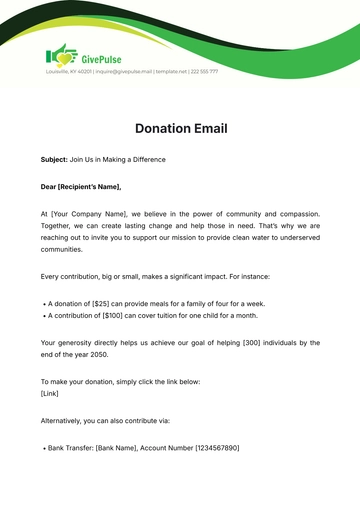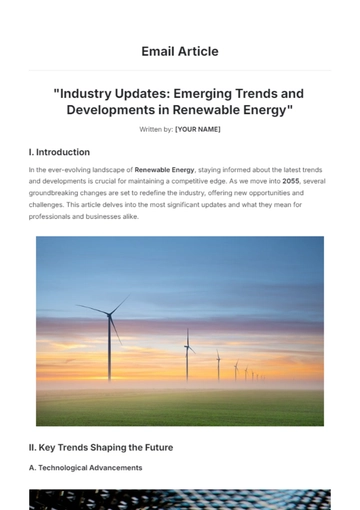Free Email Marketing Campaign Strategy

I. Introduction
[Your Company Name] has developed a campaign strategy to elevate its email marketing effectiveness in [2051]. This plan focuses on data-driven techniques, audience engagement, and strategic execution to ensure optimal results. By leveraging industry best practices and innovative approaches, [Your Company Name] aims to enhance customer acquisition, retention, and satisfaction through tailored email marketing campaigns.
II. Audience Segmentation
Understanding the audience is critical to crafting impactful email campaigns. Segmenting the audience based on data allows [Your Company Name] to tailor messaging and offers effectively.
Demographics: Analyze age, gender, income level, and location to create relevant email campaigns. Accurate targeting ensures higher engagement.
Behavioral Data: Focus on purchase history, browsing behavior, and previous interactions. This data provides insights into customer preferences.
Engagement Levels: Categorize subscribers based on their level of interaction with previous emails. Identify active, inactive, and new subscribers for customized strategies.
Customer Needs: Assess individual needs using surveys and feedback. Personalized emails addressing these needs improve satisfaction and loyalty.
Advanced Segmentation: Incorporate psychographic factors such as interests, values, and lifestyles. This deepens audience understanding and enhances message resonance.
III. Content Strategy
Compelling content drives the success of email marketing campaigns. By delivering value-driven, actionable, and visually appealing content, [Your Company Name] ensures its messages stand out in crowded inboxes.
Personalized Content: Use subscriber names and tailored recommendations to establish a personal connection. Personalized emails boost open and click-through rates.
Engaging Headlines: Craft attention-grabbing subject lines that encourage readers to open emails. A/B testing ensures optimization of headlines.
Visual Appeal: Incorporate high-quality images, infographics, and videos to make emails visually engaging. Balance visual elements with concise, clear text.
Actionable Call-to-Actions (CTAs): Use compelling CTAs to guide recipients toward desired actions. CTAs should be strategically placed and relevant to the content.
Value Proposition: Highlight exclusive offers, informative content, or solutions to problems. Demonstrating value fosters trust and engagement.
IV. Performance Metrics and Goals
Tracking performance metrics ensures that campaigns align with defined goals and objectives. Regular analysis allows for course corrections and strategy refinement.
The [2051] targets reflect ambitious yet achievable improvements in key metrics. Increased focus on personalized content and segmentation is expected to drive higher engagement and conversions. Subscriber growth strategies will be pivotal to expanding the email reach.
V. Campaign Calendar
A well-defined campaign calendar ensures timely execution and effective resource allocation. The calendar aligns campaigns with critical sales and engagement periods. A mix of promotional and re-engagement themes ensures balanced growth throughout the year. Strategic timing capitalizes on high-traffic months.
Month | Campaign Theme | Goal |
|---|---|---|
January | New Year Offers | Drive early-year sales |
April | Spring Discounts | Boost seasonal engagement |
July | Mid-Year Review | Re-engage inactive subscribers |
October | Holiday Prep | Maximize pre-holiday purchases |
December | Year-End Wrap-Up | Build momentum for the new year |
VI. Tools and Platforms
Effective campaigns require robust tools and platforms to streamline processes. [Your Company Name] employs state-of-the-art technologies for enhanced performance.
Email Automation Tools: Automate email scheduling, delivery, and follow-ups. Automation ensures consistency and saves time.
CRM Integration: Centralize customer data for personalized email marketing. CRM systems provide valuable insights for segmentation.
Analytics Platforms: Use analytics tools to monitor and evaluate campaign performance. Real-time data supports informed decision-making.
Content Creation Tools: Leverage graphic design and video editing software for high-quality email content. Professional visuals increase engagement.
AI Integration: Employ AI to predict customer behavior and optimize email timing. AI-driven insights enhance campaign effectiveness.
VII. Budget Allocation
A detailed budget ensures efficient use of resources and aligns expenses with strategic priorities. The budget emphasizes key areas like automation and content creation, which directly impact campaign quality. A substantial allocation to analytics supports data-driven decision-making. Miscellaneous funds allow flexibility for unexpected needs.
Expense Category | Projected Cost |
|---|---|
Automation Tools | $10,000 |
Content Creation | $8,000 |
Analytics and Reporting | $6,000 |
Customer Surveys and Data | $4,000 |
Miscellaneous Expenses | $12,000 |
VIII. Competitor Analysis
Analyzing competitors provides insights into industry trends and benchmarks for performance.
Industry Leaders: Identify top-performing competitors and analyze their strategies. Benchmarking ensures competitive positioning.
Content Strategies: Study competitor email designs, CTAs, and engagement tactics. This inspires innovation in campaign planning.
Customer Feedback: Monitor competitor reviews and feedback to identify gaps. Addressing these gaps can create a unique value proposition.
Market Trends: Evaluate industry trends influencing email marketing. Adapting to these trends ensures relevance.
Performance Metrics: Compare metrics such as open rates and conversion rates. Understanding benchmarks helps set realistic goals.
IX. Training and Team Development
Well-trained teams are integral to executing successful email campaigns. [Your Company Name] emphasizes skill development to ensure excellence.
Workshops and Webinars: Organize regular training sessions on email marketing trends. These sessions enhance team expertise.
Certification Programs: Encourage participation in certification programs for advanced email marketing techniques. Certifications enhance credibility.
Knowledge Sharing: Foster a culture of knowledge sharing within teams. Collaboration leads to innovative campaign strategies.
Feedback Mechanisms: Use performance reviews and feedback to identify training needs. Addressing gaps ensures continuous improvement.
Cross-Functional Training: Equip team members with knowledge of other functions. This holistic understanding improves campaign coordination.
X. Conclusion
This campaign strategy plan positions [Your Company Name] to achieve significant improvements in email marketing outcomes. By leveraging data, personalization, and cutting-edge technologies, the company aims to exceed its [2051] targets. Continuous evaluations and adjustments will keep the strategy aligned with dynamic market demands.
- 100% Customizable, free editor
- Access 1 Million+ Templates, photo’s & graphics
- Download or share as a template
- Click and replace photos, graphics, text, backgrounds
- Resize, crop, AI write & more
- Access advanced editor
Streamline your promotional efforts with the Email Marketing Campaign Strategy Template from Template.net. Fully editable and customizable, this template is ideal for planning email sequences, target audiences, and campaign goals. Use our AI Editor Tool to personalize it with your branding and content. Its strategic layout ensures effective communication, drives engagement, and boosts conversions.





























